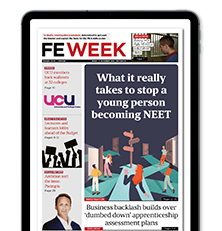Most colleges make the same mistake on social media – they talk at students, not with them.
It’s a classic case of institutions misunderstanding their audience. Your social team spends time crafting polished updates, sharing official news and broadcasting messages that they think are important.
But here’s the uncomfortable truth. Most students don’t care. Not because they dislike your institution. Not because they’re disengaged. But because, in their world, interacting with official accounts just isn’t cool.
They’re not going to share your latest campus update with their mates. They’re not rushing to comment on a post about your latest news story. They don‘t care that your local mayor came to look at a classroom. And they’re definitely not leaving enthusiastic comments under a corporate sounding caption. Maybe their parents will. But students? Unlikely.
So if they’re not engaging, then what’s the point? Should colleges just give up on social media? No, but they need to get smarter about how they use it.
Instead of pushing out more corporate content, create content students actually want to engage with.
The list is long, but the three main reasons why students are ignoring your social media content are straight forward.
It feels too corporate
Most institutional social media accounts sound like a press release. Formal, polished, professional, which is everything students actively avoid in their own feeds.
If your posts read like they’ve been written for a committee, rather than by a human, students will scroll straight past.
Bear in mind this is also the reason your news stories will be some of the lowest ranked pages on your website.
It doesn’t speak to them
Think about the content students actually engage with. It’s personal, relatable, often funny, and always relevant to their lives. If your posts focus solely on institutional priorities, rather than student interests, you’re talking into the void. Those posts with case studies selling your courses? Forget it.
There’s no reason to share it
Social media is about self-expression. People share content that makes them look good, makes their friends laugh, or sparks a conversation. A campus press release doesn’t tick any of those boxes. Believe it or not, students want to look cool in front of their peer group.
So how do you cut through? Instead of pushing out more corporate content, create content they actually want to engage with:
Make students the stars
If a student’s face, voice or story is in a post, they’re far more likely to engage with it and share it. But here’s the important part; it has to be authentic. No overly scripted testimonials or case studies, no awkwardly staged photos. Think student takeovers, day-in-the-life videos, and user-generated content that feels natural, not forced.
Lean into humour
What’s the best performing college content? It’s rarely the official news updates. It’s the memes, the tongue in cheek videos, and the self-aware posts that are relatable. The posts that feel like they’ve been written by someone who actually understands student life, not by a marketing department trying to sound “down with the kids”.
Tap into student pride
Students might not share your official announcements, but they will share something that makes them feel proud. Give them something they want to show off. Whether it’s a sports victory, a student achievement, a quirky campus feature (the strange staircase that goes nowhere, the best study spot, the most epic takeaway item on the menu), or simply a reminder that they’re part of something special.
And here’s one bonus tip to get your team to implement right away. Be useful.
What are students actually asking about? Careers, student finance, where to find the best cheap eats near campus? Answer those questions. That beloved local chicken shop all the students go to? Feature it. That niche but essential piece of student advice? Post it.
The institutions winning on social media aren’t trying to be cool, they’re being useful, entertaining and authentic. Because here’s the thing: most students won’t engage with an institutional account. But they will engage with content that speaks to them, not at them.
So, take a moment and look at your last post. Would you engage with it if you were a student? If not, it’s time to rethink your strategy.















Really refreshing read – and on the money!
Excellent read, Adrian! Totally agree with this. Having worked for a college there definitely needs to be a lot more engagement with students. Like you said, we need to create ‘content that speaks to them, not at them’!
I agree with Adrian! Colleges have to understand how to connect with their audiences, and making the students the stars of the show is the way to go.
So true Adrian. It’s so important to understand your audience and share what’s they want to see. Not what you think is important. Agreed about the corporate bit. And yes make them the stars!
Hey Adrian, this is great topic and yes colleges fail on social media by broadcasting and not engaging. Here’s an idea try to connect, be authentic, use humor, feature students, and offer useful content. Also, focus on what students want to share, not corporate messaging, for genuine interaction.
Brilliant read, it’s a fantastic piece
As leaders, we really need to hear this. The posts that actually land with students are the ones that feel real and relatable and are about connection, not just comms. If we want students to engage we need to show we’re listening. Thank you.
Perhaps you shoul ask the students to produce the content??? (they do it all the time).
Art, Design, Business plan and content, works towards course content credits.
Dont make it about them, let them make it about them, its their establishment, their time.
No brainer.
Top article!
More of this, please. We need honest comment like this if we’re serious about improving student engagement.
Hey Adrian, this is great topic and yes colleges fail on social media by broadcasting and not engaging. Here’s an idea try to connect, be authentic, use humor, feature students, and offer useful content. Also, focus on what students want to share, not corporate messaging, for genuine interaction.
I keep coming back to this. It’s a really good take on what needs to be done.